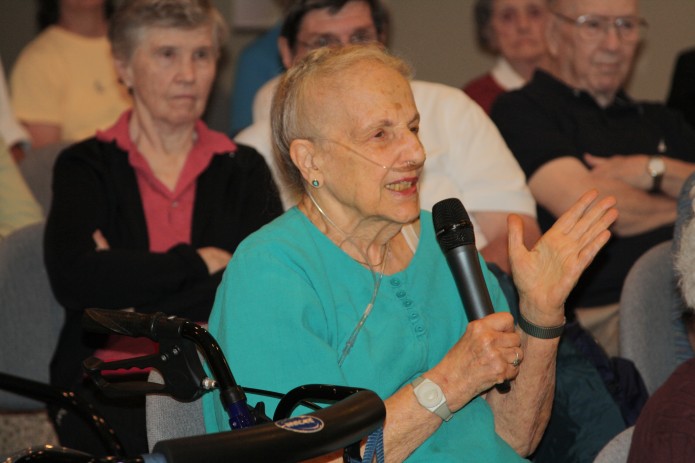
Jean Gore, former US section President of Womens International League for Peace and Freedom speaking July 8, 2012 at Neutron Trail Nuclear Disarmament: Don’t Stop Now” talk, Frasier Meadows Retirement Community, Boulder, CO. Photo: Alan Cogen, © Olivia Fermi 2012.
I’ve just returned from a Neutron Trail trip which began in Boulder, CO, where I gave a public talk on the world nuclear disarmament movement to approximately 75 people. In our planning conversations, the organizer at the retirement community hosting the event emphasized how engaged and articulate the audience would be. Wow was she ever right!
I’ve given this talk once before and the Q&A, naturally, was quite heated. My initial response was to try and control things but with the thought of this particular audience and the encouragement of a revered colleague of mine, I decided to do an experiment and open things up more.
Arriving at the hall, Neutron Trail stories began to flow. I was greeted by Pete, a retired palaeontologist, who helped me set up my equipment. With excitement he told me he knew Franco Rasetti, one of Enrico Fermi’s closest friends and colleagues. Rasetti refused to work on the first atomic bomb, taught physics and became a palaeontologist.
Instead of having participants share with each other at the beginning and/or end of the talk as I usually do, I invited them to speak during the presentation. One person agreed to be the timer so no one spoke for more than three minutes. Close to a dozen people shared their recollections, adding depth and color to the evening.
Boulder, CO is less than 400 miles from Los Alamos, NM where the first atomic bombs were conceived, engineered and assembled during the height of World War II. Now, Los Alamos hosts Los Alamos National Laboratory (LANL), an active top-secret military facility. Apparently, most of LANL’s budget goes toward caring for aging nuclear weapons.
LANL’s own website says, “Our primary responsibility is ensuring the safety, security, and reliability of the nation’s nuclear deterrent... Lab R&D helps curb a wide variety of threats to U.S. interests—whether it’s the proliferation of nuclear weapons, the spread of deadly diseases, inadequate supplies of energy, or the effects of climate change. ”
The history of the global nuclear disarmament movement has been built by courageous individuals from all nations and walks of life. It’s punctuated with successes. After sharing a few, I asked the audience to share their stories.
One man told of being a boy at Los Alamos where his father was a physicist during the Manhattan Project. He had thoughts of following in his dad’s footsteps but changed his mind, seeing the militarization of physics continuing into the Cold War.
Eleanor, 94, a retired computer scientist, fondly remembered working with Enrico Fermi in her 20’s, helping him run numbers on early computers. She said, “He was faster than me.”
A retired military man, Alan, spoke of the horror of seeing U.S. atomic bomb tests carried out. “I watched towers melted and buildings vaporized.” He added, looking me directly in the eye, the weight of it palpable in his words, “Twenty seven times.”
Another woman read to us the chilling outcome of filming “The Conqueror” (1956) downwind of the Nevada Nuclear Weapons Test site. The film starred John Wayne, who along with 45 others from the cast and crew died of cancer.
Boulder, CO neighbors Rocky Flats, the retired nuclear weapons facility implicated for inadequate and inept safety practices causing environmental poisoning and higher than normal cancers in the area.
Both men and women shared Rocky Flats protest stories, with local artist Jane Dalrymple-Hollo inviting us to participate in Rocky Mountain Peace and Justice Center (RMPJC) activities. She told the story of how the center was born out of the non-violent Rocky Flats protests and is founded on principles of stewardship for life — both for our planet and for humanity.
My talk itself is a salute to groups like Women’s International League for Peace and Freedom (WILPF), active from 1915 to today. Jean Gore, former US section president of WILPF attended and spoke eloquently during the talk about WILPF’s Nevada Test Site protest and the current RMPJC lobbying efforts to properly clean up rather than mask contamination at Rocky Flats.
On top of toxic waste from nuclear weapons facilities, in the talk, I explore how nuclear weapons and international security affect and are affected by climate change.
WILPF, Campaign for Nuclear Disarmament, Pugwash Conferences, SANE, Greenpeace and many more started out of a mutual affinity among individuals and a shared outlook based in some external commonality: e.g. as women, scientists, activists or nationals of a certain country or region.
The latest thrust in the world nuclear disarmament movement is coming from world leaders. Global Zero, founded in 2008, offers a concrete plan to eventually rid the world of nuclear weapons. Endorsers include: U.S. President Obama; Russian Prime Minister Medvedev; military leaders from around the world including General (Ret.) Jehangir Karamat, former Chairman of the Pakistani Joint Chiefs of Staff and Pakistani Ambassador to the U.S; Iranian Amb. Seyed Hossein Mousavian; and Archbishop Desmond Tutu.
With so many obvious obstacles to achieving world peace and security, it is heartening to see the conversation about global nuclear disarmament moving into the ranks of those with the theoretical power to rid the world of nuclear weapons.
Here is Global Zero signatory Queen Noor of Jordan on moving forward with global nuclear disarmament:


 Twitter
Twitter
One Response to Nuclear Disarmament: Don’t Stop Now!